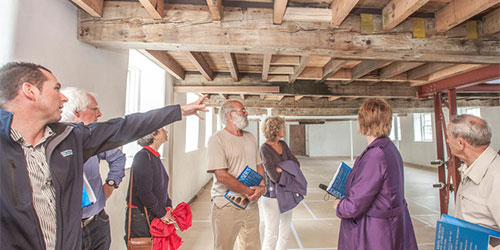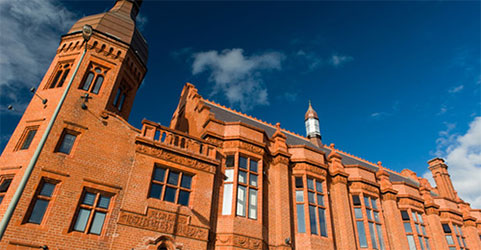Explore the Architectural Heritage Fund’s interesting and varied case studies here and enjoy two case study spotlights below.
Though specific to the AHF, these case studies demonstrate the transformative effects of funding.
Cromford Mills, Derbyshire

What’s so special about Cromford Mills?
The mill has been described as the most important preserved textile heritage site in the world. It is from these buildings that Sir Richard Arkwright developed technology that gave rise to the industrial revolution by creating the modern factory system.
Why was the building under threat?
It was generally believed the mills had reached the end of their useful life and must be demolished – all of the key buildings had fallen into disrepair and many of the historic features of the site, including the principal watercourse, had been obliterated by modern development. The colour works that was the last industrial use had left significant contamination. So degraded had the site become that the Local Authority believed it had lost too much of its original integrity and that it was no longer historically important.
How was it saved?
The Arkwright Society purchased the mill site in 1979 supported by a loan from AHF as an act of rescue, and in the early 1980s began to implement its long-term economic plan. The strategy identified the buildings that were not required for the Society’s own uses and so could be repaired and leased to tenants. The aim was to create a rental income to cross subsidise the Society’s overheads and the costs of delivering services to the general public visiting the site. The society was also able to implement a programme of repairs and conservation, and once some of the more modern buildings were removed the true significance of the complex was revealed, leading to the inscription as a World Heritage Site.
How is the building used now?
The Arkwright Society have a popular visitor centre, the Arkwright Experience serving as a gateway to the site including a 3d interactive model and virtual reality show. In the early 1990s the Society developed further income streams from a restaurant and shops run by its trading arm, Cromford Mill Limited. Many of the buildings have now been brought back into economic use and the site has creative industries managed workspace, two restaurants, several meeting rooms, office accommodation for rental, galleries and several shops.
How did the AHF help?
The AHF’s involvement with the project goes all the way back to 1979, when it first offered a loan enabling the Arkwright Society to buy Cromford Mills. This makes the Arkwright Society AHF’s longest-established client. More recently AHF provided a project development grant of £25,000 and a loan of £510,000, supporting the Arkwright’s society’s ambitious four-phase masterplan for the site to become self-sustaining.
Cromford Mills also featured in The Heritage Alliance’s Inspiring Creativity report.
Florence Institute, Liverpool

AHF Florence Institute support summary
The AHF provided a working-capital loan for the duration of the restoration work, to ensure cashflow was maintained and prevent any stoppages to work.
New use summary
Open seven days a week, the building offers a wide variety of participatory activities for people of all ages, multi-purpose event spaces available for hire and fully inclusive workspaces for businesses.
What’s so special about Florence Institute?
Built in 1889, the Florrie was the first building in Britain to be specifically constructed as a boys’ youth club. It served the working and unemployed youth of the dockside area of The Dingle in Liverpool for almost 100 years until its closure.
Why did the AHF get involved?
The Trust identified a funding gap that could be overcome by a loan offer so that the restoration could commence on site.
Why was the Florence Institure under threat?
Towards the end of 1980s funding for the Institute dried up and in 1987 the building was sold for development. It grew increasingly derelict over the following 20 years.
How was it saved?
In 2004 the plight of the Florrie was featured as part of the Liverpool Echo’s “Stop the Rot” campaign which raised the profile of the derelict building widely. The Florence Institute Trust Ltd was formed by concerned members of the local community to find a new and sustainable use. It went on to raise over £6M funding for its comprehensive restoration.
How is the building now?
The Florrie once again serves the locality by providing new jobs and much needed community facilities. There is managed workspace for local entrepreneurs and businesses, flexible community space for events, conferences, exhibitions and youth activities and a multi-functional events hall that encompasses everything from knitting, to keep fit and parties.
How did the AHF help?
The Trust approached the AHF whilst there was still a shortfall with capital funding, so that a loan offer could allow work to begin without any delay. Subsequently the facility was used as working capital, to pay contractors in between payments from capital grant funders, avoiding costly delays.
Header Image Credit: Oliver Brodrick-Ward
Case Study Images © The Architectural Heritage Fund
